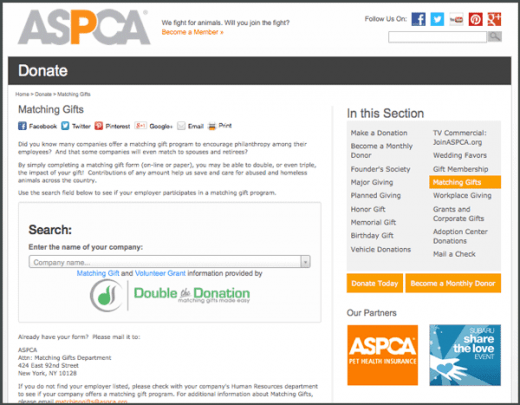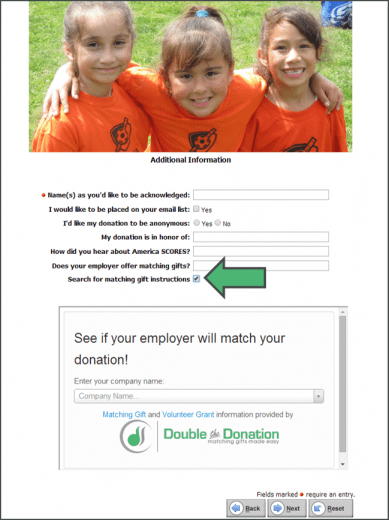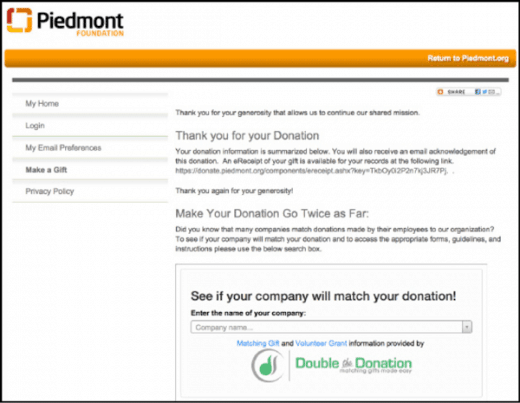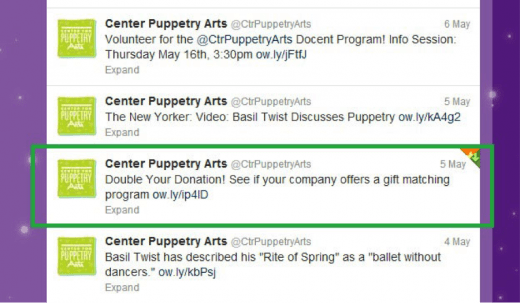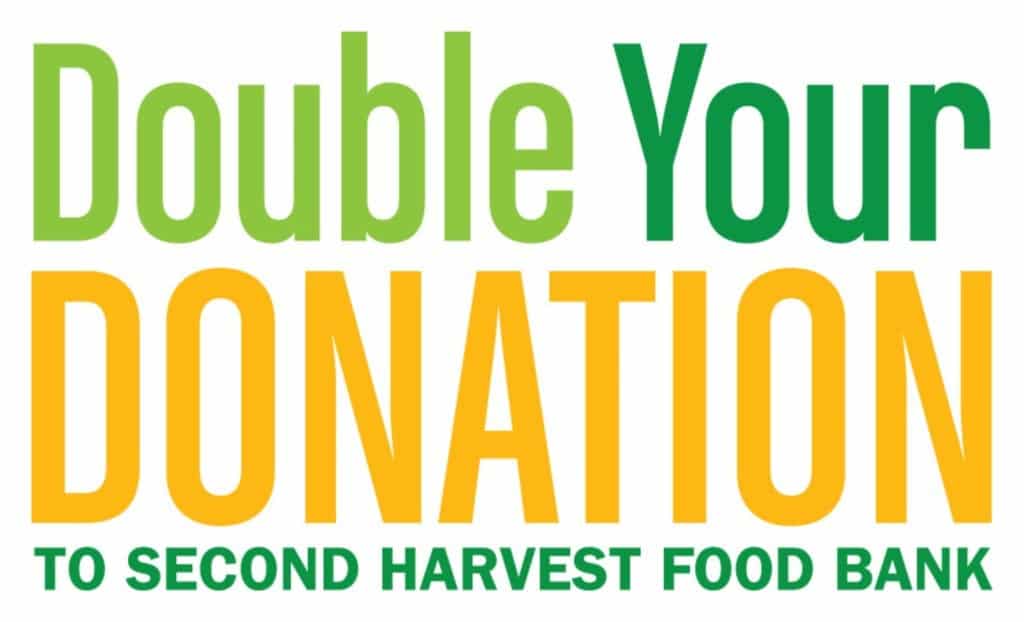
Five Easy Ways to Market Matching Gifts
If money is given to a nonprofit but no matching gift appeal is made, the nonprofit will most likely not receive the maximum possible donation. Matching gifts are for fundraising and it’s paramount to inform donors that their contributions can go twice as far with an assist from corporate giving.
Marketing matching gifts helps to increase awareness, so that as many donations as possible can be doubled, tripled, and sometimes quadrupled. The following are simple, effective ways to market matching gifts to both donors and your nonprofit’s expansive community.
Direct Mail or Email Newsletters
Dedicated supporters enjoy updates and learning more about your nonprofit. Part of educating supporters is informing them of the bevy of donation options at their disposal, which includes matching gifts.
The best place to include this information is your newsletter (print and email). As you plan your nonprofit’s content strategy, make sure you’re finding ways to include requests for matching gifts. Whether newsletters are sent daily, weekly, or monthly, incorporating matching gift information can help to remind donors about corporate giving at the times of year when the most donations come in, such as at the end of the year.
EXAMPLE: National Kidney Foundation provides an example of how to incorporate matching gifts into an email newsletter: 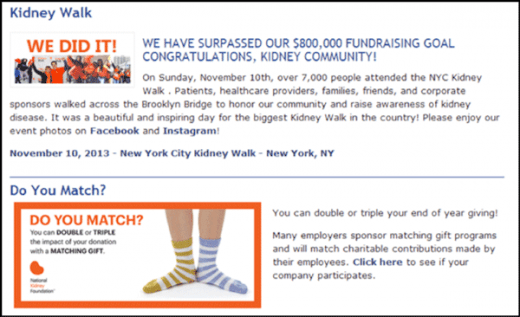
This newsletter splits space between a recent Kidney Foundation event and matching gifts. A newsletter dedicated entirely to matching gifts ensures that readers’ focus isn’t strained. The Charcot-Marie-Tooth Association presents a newsletter all about matching gifts:
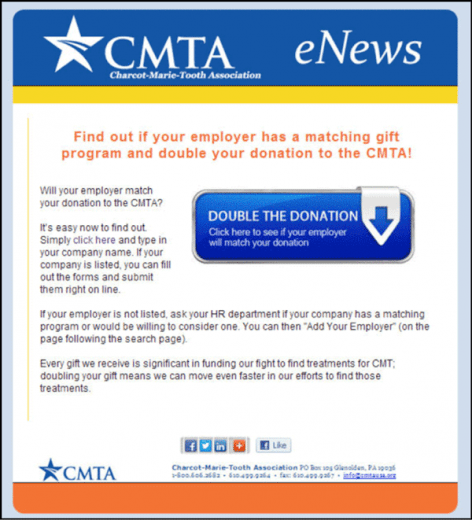
It’s good to send a dedicated matching gift newsletter at least once or twice a year to ensure your donors know about this giving option. People might miss the first email or read it and forget, so more than one message can help to reinforce the information.
While email may be king, don’t discount direct mail. It is still considered an extremely effective marketing technique. Many nonprofits’ donors are older and prefer direct mail to more modern messaging methods, such as email. Direct mail helps your nonprofit reach its less tech-savvy donors in order to increase the reach of your matching gift marketing.
Acknowledgement Letter
Say thank you to donors. A whopping 72% of charitable donations come from individuals, and their contributions do a lot for your nonprofit. A startling number of organizations fail to send acknowledgement letters, and doing so could be the difference between retaining and losing donors.
Saying thank you is an opportunity to promote matching gifts as well, which the Piedmont Healthcare Foundation does in their donation acknowledgement email:
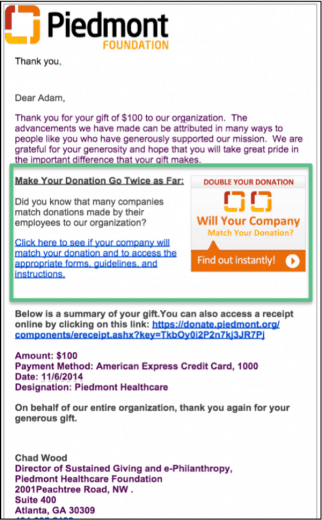
By including information about matching gifts in your thank you, you’re giving the donor the chance to give more, and thus do more, when he or she clearly wants to help your organization. Asking for matching gifts is a smart way for nonprofits to raise more money through well-crafted emails.
Dedicated Matching Gift Page
When you place a matching gift link in a newsletter or acknowledgement email, where does it take donors? To your dedicated matching gift page, of course. Nonprofits have several options for what a good dedicated matching gift page should look like and do. How a page functions depends on your organization’s budget and the needs of your donors.
An effective dedicated matching gift page does not need to be fancy, but it should include helpful information, such as:
- Matching gift statistics
- Links to relevant websites
- How much money your nonprofit has raised from matching gifts in the past
- A list of companies who offer matching gifts
- Tips on how to submit matching gift forms
For nonprofits with money to spend, matching gift pages can incorporate search boxes to make it as easy as possible for donors to see if their companies offer corporate giving programs and to access the necessary forms and online portals.
The ASPCA demonstrates how to embed a matching gift search box on a dedicated matching gift page:
The search box is all about making matching gifts easier for donors. When it’s simple to figure out if a matching gift is possible, donors will be more inclined to take a few minutes to double their donations. Dedicated matching gift pages don’t need to take a lot of time. They just need to make it as easy as possible for matching gifts to be made.
The Donation Process
You can tell donors about matching gifts before donations are made or remind them after the fact, and wouldn’t it be nice if you could promote matching gifts while the actual donations are being submitted? You can.
The Association of Former Students at Texas A&M includes a matching gift link on their donation page:
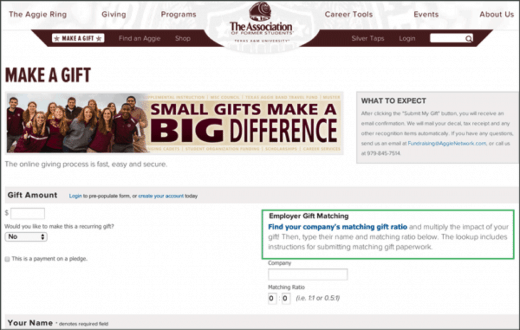
The link is a call to action at a time when people are already in a giving state of mind. If you make it easy for people to give more, and they find that they’re eligible for corporate giving, then you stand a good chance to receive more matching gifts.
Here is an example of a nonprofit using Greater Giving’s donation pages that incorporates Double the Donation’s matching gift search tool directly into the donation form:
When the donor checks the “Search for matching gift instructions” box, a matching gift search tool appears and you’re still on the same webpage. The embedded search box ensures donors won’t leave the donation page and possibly forget to donate. It also makes searching for matching gift information quick and simple.
To give donors a second chance to search for matching gifts, nonprofits can include matching gift information on the donation confirmation page, such as the Piedmont Healthcare Foundation does:
The confirmation screen is an opportunity to extend your gratefulness for the gift, but also to make another appeal for matching gifts. People want to help your organization, and sometimes it takes a few reminders before they fully realize how easy it is for their money to do even more.
Social Media
Many nonprofit donors are online. They’re on Twitter, Facebook, Instagram, and more, so it’s important to tie your fundraising and social strategies together. Take advantage of their online presence and promote matching gifts through social media. Nonprofits can thrive on social media; it’s a chance to connect with people, learn about donors, and share information.
The CTMA shows how engaging a Facebook post can be:
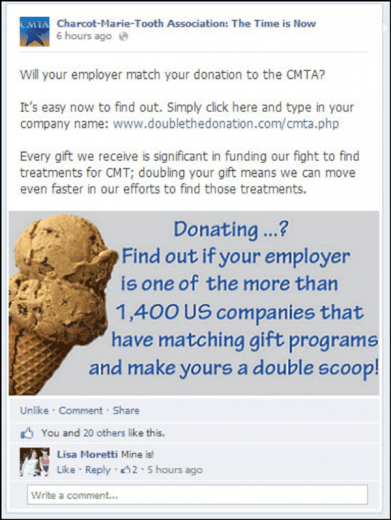
The combination of informative text and an image grabs donors’ attention. Facebook content only gets shared with a wide audience when enough people like and comment on a post, so you want donors to feel like they’re learning something from your post, or to at least feel like they’re entertained by the prospect of a two-scoop ice cream cone.
You can achieve the same goal of teaching donors about matching gifts while including an effective call to action in a Tweet as well.
The Center for Puppetry Arts demonstrates how simple a matching gift Twitter post can be:
Send a matching gift Tweet periodically, so new rounds of donors have the chance to learn how to give more. If you use a scheduling tool, such as Hootsuite, then you can schedule several Twitter posts in advance.
Promoting matching gifts requires action, but marketing doesn’t have to break the bank. Successful promotion should stem from your organization’s fundraising culture, and entails incorporating matching gift appeals across your nonprofit’s various platforms, from your website to your emails to your social media profiles. The more places that matching gifts appear, the more likely that donors will notice your appeals somewhere and consider taking the time to double their donations.

